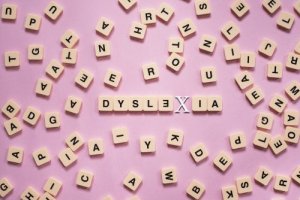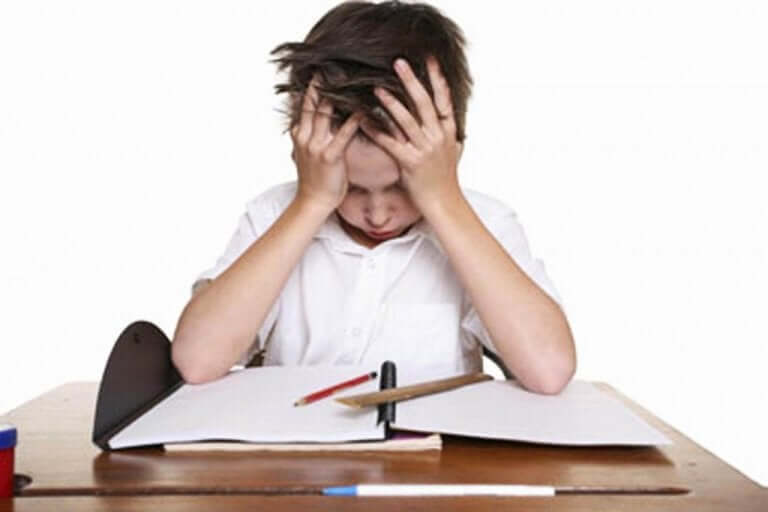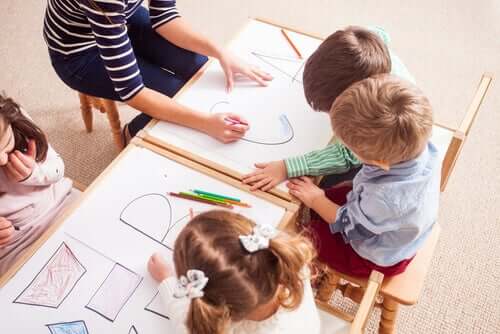Activities for Children with Dyslexia

Dyslexia is a slight learning impairment related to literacy. However, it can also lead to other difficulties in motor skills or visual and auditory perception. Other factors that may be affected are short-term memory, organizational capacity, or even speech. Activities for children with dyslexia are very important in order to treat the impairment.
Although it’s true that dyslexia is a lifelong condition, certain forms of treatment and an appropriate teaching method can help a lot.
What is dyslexia?
According to the International Dyslexia Association:
“Dyslexia is a specific learning disability that is neurobiological in origin. It is characterized by difficulties with accurate and/or fluent word recognition and by poor spelling and decoding abilities. These difficulties typically result from a deficit in the phonological component of language that is often unexpected in relation to other cognitive abilities and the provision of effective classroom instruction. Secondary consequences may include problems in reading comprehension and reduced reading experience that can impede growth of vocabulary and background knowledge.”
–Dyslexia Association–
Some signs of dyslexia
If you think your child may be suffering from dyslexia but you’re not entirely sure, here are some potential signs:
- The tendency to change the order of numbers and letters
- Trouble understanding math
- Difficulty maintaining attention
- Problems with laterality
- Problems following and learning routines
- Reading and writing take place slowly and laboriously

- Confusing the meaning of words that are pronounced in a similar way
- Altered spatial and temporal notions
- Lack of balance
- Short-term memory is affected
- Difficulty organizing thoughts
- In some cases, difficulty speaking
How to treat dyslexia?
When you first suspect that a child may have dyslexia, the most important thing is to go to a specialist who will carry out the necessary tests for diagnosis. The expert will evaluate all the areas that are involved in the development of literacy: visual, auditory, laterality, psychomotor skills, memory, among others.
The specialist will also take reading factors into account, both at a semantic and phonological level. So, once the specialist has the test results, he or she will design activities specific to the areas that each child needs.
Some activities for children with dyslexia
Knowing one’s body
Psychomotor skills are usually affected. For this reason, it’s essential to help them get to know the different parts of their bodies, and work on them.
Depending on their age, we can design activities that ask them to name and point out the parts of their bodies. A very useful activity for children with dyslexia is to make a puzzle with the silhouette of their whole body, and then get them to put it together correctly.
Spacial awareness and time-based activities
Children with dyslexia have trouble identifying the concepts of up and down, left and right, and before and after. Because of that, it’s very important to develop techniques in these areas.
For example, ask them to move from left to right every time you change some music, or to color all the flowers on a sheet of paper a specific color. Another useful activity is for them to chronologically order a picture story, or to stand either behind or in front of their classmates.
Forming words
As we’ve said, literacy is the key to the problem, and so that’s the area that you need to work on most of all. The classic game of forming words from letters can be a difficult challenge to overcome, but very productive.
Looking for letters
To work on their selective attention, you can use exercises in which they have to identify the words that have a certain letter, or that begin or end with another letter. In this way, they learn to tell letters apart.

Reading stories
By reading stories you can create a lot of activities for children with dyslexia: from reading, to understanding and memory activities. You can also ask them what they understand in the story, and suggest they invent an alternative ending.
Alternatively, you can check if they’ve paid attention by asking them questions about the story or asking them what they think will happen next.
However, don’t focus only on reading stories. You can train them to read anything if you show them it’s a fun activity. For example, cookie ingredients, car license plates, or street signs.
Using Twister
This classic floor game with colored circles is perfect for working laterality. When they have to carry out instructions such as “your right hand on green and your left foot on blue” then it’s a challenge, but great fun at the same time!
In conclusion, we’ve seen that there are many different and varied activities for children with dyslexia, and each take a very different approach. In short, the most important thing is to remember that, even though it’s a disorder that will never completely disappear, you can control it as long as doctors diagnose it early and proper treatment is provided by professionals.
Dyslexia is a slight learning impairment related to literacy. However, it can also lead to other difficulties in motor skills or visual and auditory perception. Other factors that may be affected are short-term memory, organizational capacity, or even speech. Activities for children with dyslexia are very important in order to treat the impairment.
Although it’s true that dyslexia is a lifelong condition, certain forms of treatment and an appropriate teaching method can help a lot.
What is dyslexia?
According to the International Dyslexia Association:
“Dyslexia is a specific learning disability that is neurobiological in origin. It is characterized by difficulties with accurate and/or fluent word recognition and by poor spelling and decoding abilities. These difficulties typically result from a deficit in the phonological component of language that is often unexpected in relation to other cognitive abilities and the provision of effective classroom instruction. Secondary consequences may include problems in reading comprehension and reduced reading experience that can impede growth of vocabulary and background knowledge.”
–Dyslexia Association–
Some signs of dyslexia
If you think your child may be suffering from dyslexia but you’re not entirely sure, here are some potential signs:
- The tendency to change the order of numbers and letters
- Trouble understanding math
- Difficulty maintaining attention
- Problems with laterality
- Problems following and learning routines
- Reading and writing take place slowly and laboriously

- Confusing the meaning of words that are pronounced in a similar way
- Altered spatial and temporal notions
- Lack of balance
- Short-term memory is affected
- Difficulty organizing thoughts
- In some cases, difficulty speaking
How to treat dyslexia?
When you first suspect that a child may have dyslexia, the most important thing is to go to a specialist who will carry out the necessary tests for diagnosis. The expert will evaluate all the areas that are involved in the development of literacy: visual, auditory, laterality, psychomotor skills, memory, among others.
The specialist will also take reading factors into account, both at a semantic and phonological level. So, once the specialist has the test results, he or she will design activities specific to the areas that each child needs.
Some activities for children with dyslexia
Knowing one’s body
Psychomotor skills are usually affected. For this reason, it’s essential to help them get to know the different parts of their bodies, and work on them.
Depending on their age, we can design activities that ask them to name and point out the parts of their bodies. A very useful activity for children with dyslexia is to make a puzzle with the silhouette of their whole body, and then get them to put it together correctly.
Spacial awareness and time-based activities
Children with dyslexia have trouble identifying the concepts of up and down, left and right, and before and after. Because of that, it’s very important to develop techniques in these areas.
For example, ask them to move from left to right every time you change some music, or to color all the flowers on a sheet of paper a specific color. Another useful activity is for them to chronologically order a picture story, or to stand either behind or in front of their classmates.
Forming words
As we’ve said, literacy is the key to the problem, and so that’s the area that you need to work on most of all. The classic game of forming words from letters can be a difficult challenge to overcome, but very productive.
Looking for letters
To work on their selective attention, you can use exercises in which they have to identify the words that have a certain letter, or that begin or end with another letter. In this way, they learn to tell letters apart.

Reading stories
By reading stories you can create a lot of activities for children with dyslexia: from reading, to understanding and memory activities. You can also ask them what they understand in the story, and suggest they invent an alternative ending.
Alternatively, you can check if they’ve paid attention by asking them questions about the story or asking them what they think will happen next.
However, don’t focus only on reading stories. You can train them to read anything if you show them it’s a fun activity. For example, cookie ingredients, car license plates, or street signs.
Using Twister
This classic floor game with colored circles is perfect for working laterality. When they have to carry out instructions such as “your right hand on green and your left foot on blue” then it’s a challenge, but great fun at the same time!
In conclusion, we’ve seen that there are many different and varied activities for children with dyslexia, and each take a very different approach. In short, the most important thing is to remember that, even though it’s a disorder that will never completely disappear, you can control it as long as doctors diagnose it early and proper treatment is provided by professionals.
All cited sources were thoroughly reviewed by our team to ensure their quality, reliability, currency, and validity. The bibliography of this article was considered reliable and of academic or scientific accuracy.
- Coalla, P. S. (2009). Intervención en dislexia evolutiva. Revista de Logopedia, Foniatria y Audiologia. https://www.sciencedirect.com/science/article/pii/S0214460309701500?via%3Dihub
- Mondragón Barrios, L. (2007). dislexia. Salud Mental. https://doi.org/10.1017/S1461145705005961
- Teles, P. (2004). Dislexia: cómo identificar. Cómo intervir. Revista Portuguesa de Medicina Geral e Familiar. https://doi.org/10.1108/14636680510590817
This text is provided for informational purposes only and does not replace consultation with a professional. If in doubt, consult your specialist.








